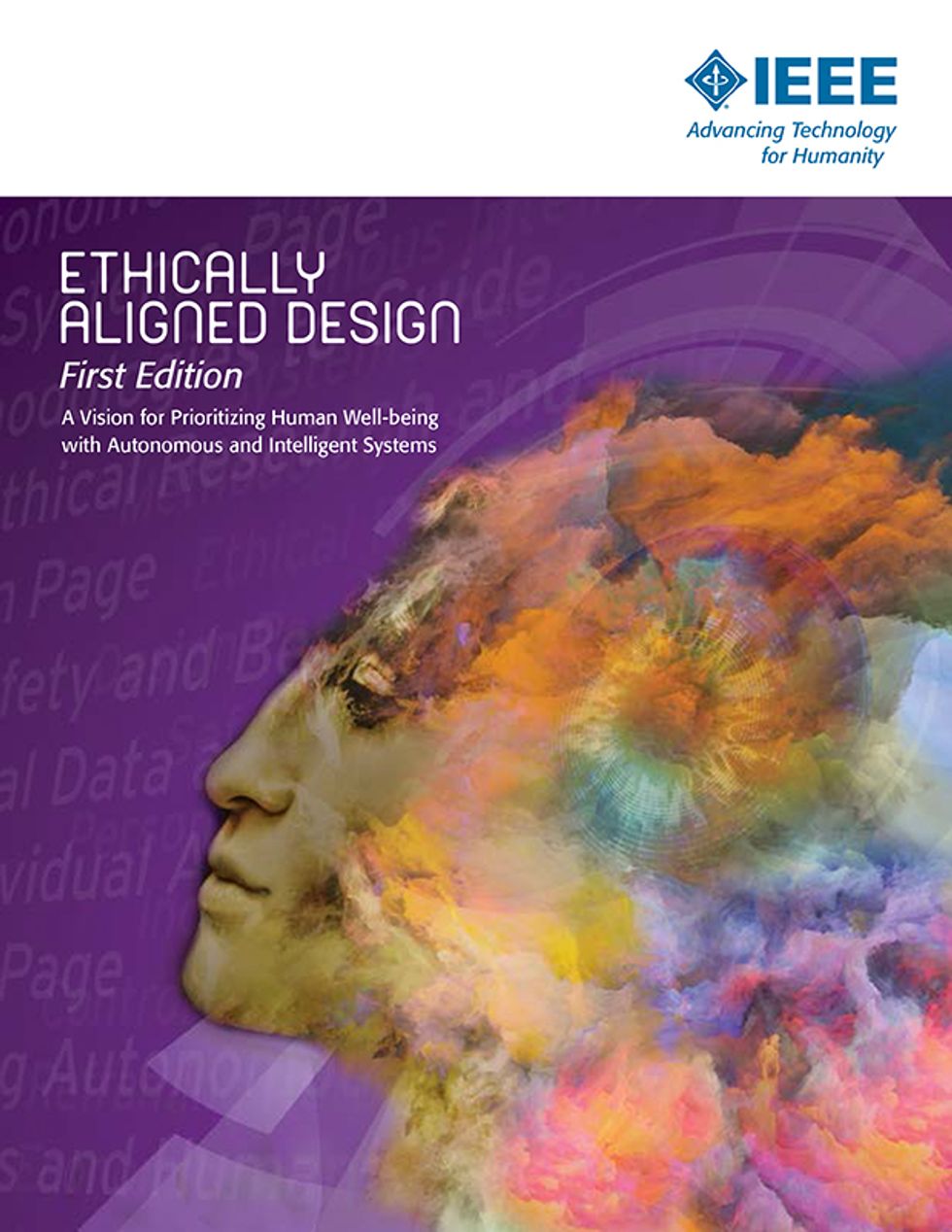THE INSTITUTEThe challenges of ethical development and the deployment of autonomous and intelligent systems (A/IS) are so broad and complex that no one organization could possibly facilitate all the necessary conversations or tangible outputs. IEEE is one of several organizations around the world working in a network-of-networks effort to increase understanding of the evolving A/IS domain.
And yet, the IEEE document “Ethically Aligned Design: A Vision for Prioritizing Human Well-being With Autonomous and Intelligent Systems, First Edition (EAD1e)” is unique. Produced by an open, global community of the IEEE Global Initiative on Ethics of Autonomous and Intelligent Systems, EAD1e is designed for and by academics, engineers, policymakers, developers, and users to ensure that A/IS align with explicitly formulated human values around human rights, well-being and environmental sustainability. EAD1e sets forth scientific analysis and resources, high-level principles, and actionable recommendations to provide guidance for standards, certification, regulation, and legislation.
Many A/IS principles released in the past few years have been geographically focused (and understandably so, given that they are intended for citizens within a particular region), but EAD1e is global in both its process and scope. The IEEE initiative involves more than 2,000 participants from around the world, representing tremendous diversity of professional disciplines. Consequently, the document doesn’t present a framework based on Western ethics only; it looks at Shinto ethics, Ubuntu ethics, and others. The authors drew on more than 3,000 years of scientific and faith-based ethics systems, including secular philosophical traditions, to address human morality in the digital age.

Another important way that EAD1e is different is that it was fundamentally a bottom-up creation. The committees that drafted the work were—and continue to be—open to anyone to join. Moreover, they chose the topics they would address. So, for example, participants in the global and multidisciplinary committee that developed the A/IS for Sustainable Development chapter—from the business community, academics in multiple fields, robotics engineers and development practitioners—were drawn specifically to the EAD1e effort to provide ethical guidance for A/IS that benefit humanity by advancing sustainable development.
IDENTIFYING ISSUES, FINDING PRACTICAL RECOMMENDATIONS
The document’s sustainable-development chapter has as its central premise that, to be ethical, AI applications must benefit humanity:
A/IS offer unique and impactful opportunities as well as risks both to people living in high-income countries (HIC) and in low- and middle-income countries (LMIC). The scaling and use of A/IS represent a genuine opportunity across the globe to provide individuals and communities—be they rural, semi-urban, or urban—with the means to satisfy their needs and develop their full potential, with greater autonomy and choice. A/IS will potentially disrupt economic, social, and political relationships and interactions at many levels. Those disruptions could provide an historical opportunity to reset those relationships in order to distribute power and wealth more equitably and thus promote social justice. They could also leverage quality and better standards of life and protect people’s dignity, while maintaining cultural diversity and protecting the environment.
The chapter has five sections, each providing background information and identifying issues, and each offering actionable recommendations. For example, the first section, A/IS in Service to Sustainable Development for All, identifies an issue that current A/IS roadmaps “are not aligned with or guided by their impact in the most important challenges of humanity,” as defined in the 17 United Nations Sustainable Development Goals (SDGs).
Our committee could have spent all our discussion time defining what constitutes “benefit to humanity.” Instead, we chose the U.N. goals because every country had the chance to participate in their development—via government, the private sector, youth groups, and other organizations—and answer the question, “What is the future we want?” The goals were the result of a multiyear process and multi-stakeholder dialogue, all structured around human well-being, and ultimately adopted in the U.N. General Assembly by 193 countries.
The global participatory process and the countries’ almost universal adoption in 2015 made the SDGs a suitable proxy for measuring A/IS’ benefit to humanity. A key consideration of the SDG agenda is that pursuit of the goals should “leave no one behind.” The committee was aware that A/IS have the power to accelerate or reduce global inequality, and it developed its recommendations to further the contribution the technology can make to improve the lives of people in LMIC, as much as those in HIC.
EAD1e’s sustainable-development chapter includes several actionable recommendations such as identifying and promoting A/IS technologies that have the most relevance to the SDGs (such as big data for agriculture and medical telediagnosis and geographic information systems for emergency planning and disease monitoring); analyzing and proposing strategies for publicly providing Internet access for all (as a means of diminishing the gap in potential benefit of A/IS to humanity, particularly between urban and rural populations); researching sustainable energy to power A/IS’ computational capacity, and integrating the SDGs into the core of private-sector business strategies and key performance indicators.
Among other issues receiving comprehensive treatment in the chapter are the impact of A/IS on workers and the job market, education, social relations, and culture, with recommendations to facilitate a positive impact.
FROM PRINCIPLES TO PRACTICE
The sustainable-development chapter of EAD1e is optimistic about the potential that A/IS have to benefit humanity and advance the SDGs—and hopefully manage the risks.
The endeavor of creating the document was an optimistic one, predicated on the hope that everyone involved in producing A/IS applications will be motivated to do so in an ethical way that respects human rights and benefits humanity. The document’s human-centric, technology-for-humanity approach is intended to inspire academics, engineers, policymakers, developers, and users around the world to advance ethical implementation of A/IS from principles to practice.
One of the reasons I am optimistic is because I learned that, in working on EAD1e, so much of what the SDGs are about is already inspiring designers of many nascent technologies.
Being part of the document’s development was an amazing opportunity to interact with thoughtful professionals, each of whom, from their diverse perspectives, contributed innovative ideas in our shared effort to help shape an ethical future for A/IS and sustainable development. I’m hopeful that EAD1e will ignite further inspiration for ethical applications that advance humankind.
Elizabeth D. Gibbons chairs the A/IS for Sustainable Development Committee for “Ethically Aligned Design: A Vision for Prioritizing Human Well-being With Autonomous and Intelligent Systems, First Edition (EAD1e),” which can be downloaded at no charge She is a senior fellow and director of the Child Protection Certificate Program at the FXB Center for Health and Human Rights, part of Harvard’s T.H. Chan School of Public Health.
